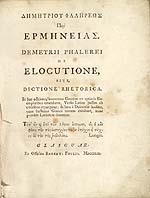 |
1743 Demetrius ‘of Phalerum’
De Elocutione
Title-page.
This was the first Greek book printed in Glasgow, and an advertisement in the
Glasgow Journal indicates that it was published on 4 April 1743.
|
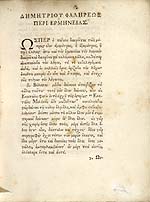 |
Text page.
In his history of the Foulis Press David Murray considered this book to be
‘an excellent piece of work’. As it was printed before Robert Foulis’s
appointment as University printer, Murray believed it could have been ‘the
essay-piece he submitted to the University as evidence of his skill’. A
limited number, such as this example, were printed on large paper.
Sp Coll Mu50-f.32; Gaskell 31
|
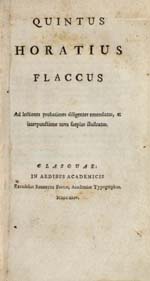 |
1744 Horace Works printed by Robert Foulis
Title-page.
This is the famous ‘immaculate’ Horace which is a key-book for collectors
of Glasgow printing. The proofs, it is said, were hung in the college, and a
reward of £50 was offered to anyone who could find any errors. However, a few
were overlooked, and six were found some time later.
|
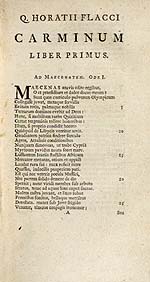 |
Text page.
In his history of the Foulis Press James Maclehose wrote ‘the Horace is a
beautiful volume, and the text nearly, but not quite perfect. Absolute accuracy,
the editors of the Homer afterwards declared, was a vana spes.’
Sp Coll BD12-e.8; Gaskell 50
|
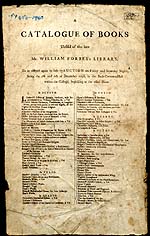 |
1746 A Catalogue of Books Unsold of the late Mr William Forbes’s
Library, December 1746.
This is one of four short, and very rare, catalogues in the University’s
collections which relate to book sales organised by the Foulis brothers. Three
of them bear their name, and although this example does not, it is likely to
have been for one of their auctions in the College.
Sp Coll f373
|
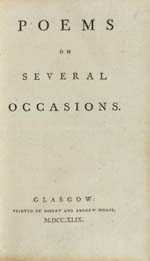 |
1749 William Hamilton of Bangour Poems on Several Occasions
Title-page.
William Hamilton (1704-54) was described as the ‘first Scotsman in the 18th
century to write poetry in good English’. The book was published without the
author’s knowledge, and the preface was written by Adam Smith.
|
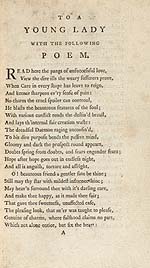 |
Text page.
The poems were sent to the Foulis Press by Hamilton’s friends when he was
living abroad because of his involvement in the 1745 Jacobite rebellion. A
second edition was brought out in 1758.
Sp Coll Mu49-e.5; Gaskell 131
|
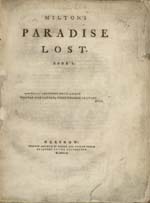 |
1750 John Milton, Paradise Lost
Title-page.
This volume was edited by John Callander of Craigforth, but did not proceed
beyond Book 1. David Murray noted in his article for the Scottish Historical
Review (January 1917), that ‘the remainder is in manuscript in the library
of the Society of Antiquaries of Scotland’.
|
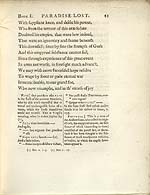 |
Text page.
The Foulis Press printed and published several editions of Paradise Lost
as well as Paradise Regained.
Sp Coll BD12-c.17; Gaskell 161
|
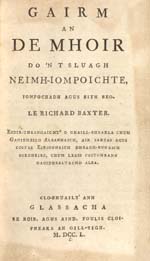 |
1750 Richard Baxter Gairm an de mhoir... (A call to the
unconverted to turn and live), printed by Robert and Andrew Foulis.
Title-page.
This was the first work of the English Divines to be published in Gaelic. The
translator was the Rev. Alexander Macfarlane of Kilninver, Argyllshire.
|
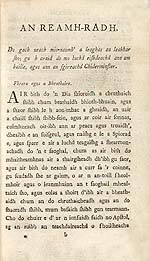 |
Text page.
This work appears to be the only example of the Foulis brothers printing in
Gaelic.
Sp Coll BD12-h.58; Gaskell 138
|
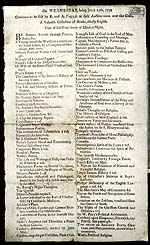 |
1752 Catalogue of a valuable collection of books, July 1752.
In addition to the bookshop in Glasgow University, the Foulis brothers owned
an auction room which was located in ‘the first land above the (Glasgow)
Cross, first fore-stair, west side of the street’. The earliest mention of
their auctions appears in the Glasgow Courant in November 1747. At a
later date they were held in the Old Coffee House at the corner of the Trongate,
on the west side of the Saltmarket.
Sp Coll f373
|
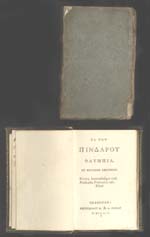 |
1754 Pindar, Works, printed by Robert and Andrew Foulis
1754-58
Title-page and blue paper wrapper.
Robert and Andrew Foulis printed books on a number of exotic materials such
as vellum, linen, and silk or satin. They also published miniature versions of
some works including Pindar’s Olympia, Pythia, Nemea and Isthmia
in three volumes. Glasgow’s Mitchell Library owns a miniature edition of Olympia
printed on silk.
The book shown first is from the set which belonged to William Hunter, and has the original blue paper covers
which Foulis used for all of the books in Hunter’s order with the exception of
the folio Homer.
Sp Coll B12-k.65-67 and Cy.3.63-65; Gaskell 274
|
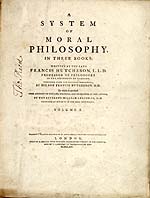 |
1755 Francis Hutcheson, A system of moral philosophy
Title-page.
Francis Hutcheson was a renowned philosopher and Robert Foulis’s mentor. He
was the author whose work was printed most by the Foulis Press, and they
published 28 editions including Metaphysicae Synopsis, 1742; A Short
Introduction to Moral Philosophy, 1747; and Thoughts on laughter, and
observations on the fable of the bees, 1758.
|
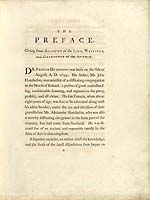 |
This two-volume publication was dedicated to Edward, Lord Bishop of Elphin,
and contains a six-page list of subscribers including the Earl of Glasgow, and
the Earl of Selkirk who ordered twelve sets. It also has an account of Hutcheson’s
‘life, writings, and character of the author’ by the Reverend William
Leechman D.D.
Sp Coll BD12-b.12,13; Gaskell 297
|
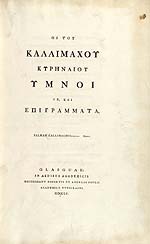 |
1755 Callimachus Hymns and Epigrams
Title-page.
This book was issued both as a quarto and as a folio. It was dedicated to the
Hon. Charles Yorke (1722-70) who was Solicitor-General of England, and one of
Robert Foulis’s greatest supporters.
|
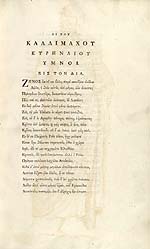 |
Text page.
The folio edition was awarded a silver medal by the Select Society of
Edinburgh. This book has been described as one of their masterpieces, and was
much sought after by collectors.
|
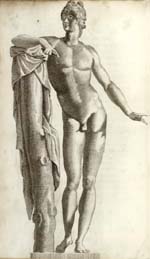 |
‘Apollo’ engraving.
The book contains three engraved illustrations of statues all of which were
copied in reverse from Antonio Francisco Gori’s Museum Florentinum. The
others were of ‘Jupiter’ and ‘Diana’. None of the engravings bears an
artist’s name, but A Catalogue of Pictures, Drawings, Prints, Statues and
Busts in Plaister of Paris, done at the Academy in the University of Glasgow,
which was printed for the Academy’s subscribers in 1758, includes a ‘Jupiter’
by James Mitchell; a ‘Diana’ by John Lawson; and an ‘Apollo’ by James
Maxwell. All of their engravings of the statues were copied from Museum
Florentinum.
Sp Coll BD12-b.17; Gaskell 283
|
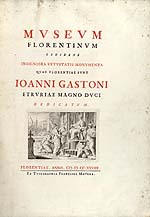 |
Antonio Francisco Gori, Museum Florentinum,
1734
Title-page.
Gori’s work, a useful compendium of antique sculpture in the Uffizi Gallery
in Florence, was published in several volumes, and provided a major source of
illustrations for the Foulis Academy’s students to copy. In June 1756 Robert
Foulis sent a memorial to the College requesting to borrow the Library’s copy
of Museum Florentinum. Within a week a meeting of the Faculty allowed him
to buy the first and third volumes for the use of his scholars. It is known that
Foulis formed a substantial art library, but there appear to be no records of
its contents, or its fate after the Academy was closed. The volumes now in the
University Library were not part of the school’s library.
|
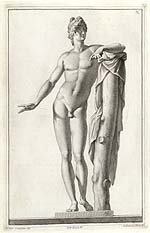 |
‘Apollo’ engraving
The Academy’s pupils copied numerous illustrations from this and other
books. In his Memorial of the Printers and Booksellers of Glasgow, 1774,
Foulis noted that Robert Simson’s mathematical works ‘could not have been
executed in the manner he chose without the art of engraving in wood; and there
are others which could not have been executed without the art of engraving on
copper. These last two arts are connected with the printing of linens and
cottons’.
Sp Coll BM.1.6
|
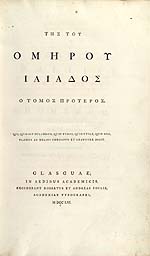 |
1756 Homer, Iliad, printed by Robert and Andrew
Foulis
Title-page.
This work, along with the Odyssey, which was published two years
later, has been described as ‘a landmark in the history of printing in Greek’.
The outstanding type was designed especially by Alexander Wilson. The large
paper copy of this two-volume work was sold for £1 11s 6d., and the small
version was £1 1s.
|
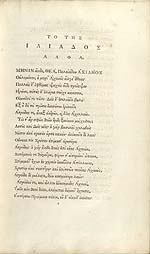 |
Text page.
It received the Edinburgh Select Society’s medal for the best printed Greek
book, and in 1757 The Scots Magazine noted that the Foulis brothers had
‘gained all the prizes yet given by this society for book-printing’. Glasgow
University sent copies to dignitaries such as William Pitt, the Duke of
Hamilton, the Duke of Argyll, and Charles, King of the two Sicilies.
Sp Coll BD12-b.18; Gaskell 319
|
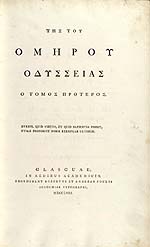 |
1758 Homer, Odyssey
Title-page.
The publication of Homer’s Iliad was followed by the Odyssey
in 1758. Both were edited by Professors James Moor and George Muirhead at
Glasgow University.
|
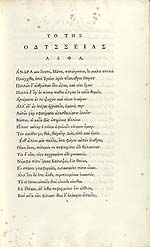 |
Text page.
David Murray wrote that ‘for beauty as well as for accuracy, these splendid
volumes can hardly be surpassed’, and quoted another who declared that the
large paper copy was ‘one of the finest monuments of Greek typography which
our nation possesses’.
Sp Coll BD12-b.19; Gaskell 319
|
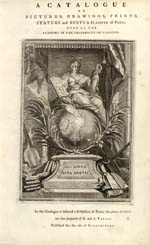 |
[1758] A Catalogue of Pictures, Drawings, Prints, Statues and Busts in
Plaister of Paris, done at the Academy in the University of Glasgow.
This catalogue was produced by Robert Foulis, and is bound with A proposal
for encouraging by subscription an Academy for painting and sculpture, now
instituted at Glasgow. The Academy was privately funded, and Robert Foulis
was always looking for new ways to raise money. The proposal was prepared by
John Dalrymple (1726-1810), an advocate and author, who was one of Foulis’s
greatest supporters and advisers. The catalogue yields valuable information on
the works produced by the Academy’s pupils.
Sp Coll Mu23-y.19; Gaskell 352
|
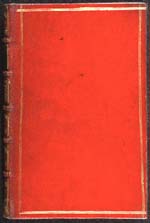 |
1759 Thucydides, Bellum Peloponnesiacum
Cover.
Robert Foulis had a binder’s shop, and David Murray noted that he ‘personally
supervised the binding of many of the finer volumes’. This particular example
is in ‘red turkey gilt’ which, apparently, was Foulis’s favourite binding.
|
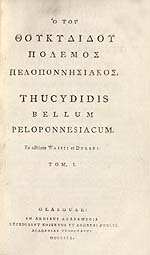 |
Title-page.
Published in eight volumes, this work has been described as ‘by far the
most correct of all the Greek Classics published at Glasgow’. Gaskell includes
a transcript of an advertisement which appeared in the Glasgow Journal on
15 August 1760: ‘Some copies are printed with the Greek and Latin on opposite
pages, and some with the translation separately. Subscribers are desired to
mention, at the time of subscribing, which sort they chuse’. This set was part
of a collection presented to William Hunter by Glasgow University, and each
volume bears an inscribed dedication.
Sp Coll Cy.3.34-41; Gaskell 375
|
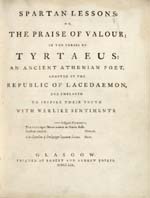 |
1759 Tyrtaeus, Spartan Lessons, printed by Robert and Andrew
Foulis
Title-page.
The work of Tyrtaeus, the 7th century B.C. elegiac poet, was used to inspire
the youth of the Republic of Lacedaemon with warlike sentiments.
|
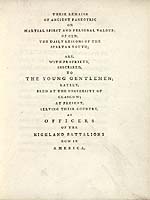 |
Text page: dedication.
In 1758 a war had broken out in North America which resulted in the capture
of Quebec. This book contains a patriotic dedication to the Scottish soldiers
who were over there.
|
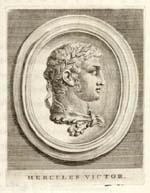 |
‘Hercules Victor’engraving.
This portrait was copied in reverse from an original in a volume of Antonio
Francisco Gori’s Museum Florentinum. It was made by one of the pupils
of the Foulis Academy and, although it does not bear the engraver’s name, it
could be by William Jameson whose engraving of the same subject is listed in the
1758 subscribers’ catalogue (Sp Coll Mu23-y.19; Gaskell 352).
Sp Coll Mu48-d.5; Gaskell 376
|
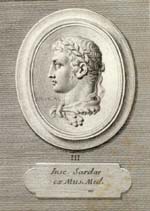 |
‘Hercules Victor’ engraving, plate I, from Antonio Francisco Gori, Museum
Florentinum, volume 2, 1732.
The volumes of Gori’s work were a useful source of illustrations for the
Academy’ pupils, and in addition to using their copies to illustrate some of
the Foulis Press publications, many were also advertised for sale in Glasgow
newspapers and the catalogue produced for subscribers. The city’s Mitchell
Library owns impressions of some of the engravings copied from Museum
Florentinum and other publications.
Sp Coll BM.1.5
|
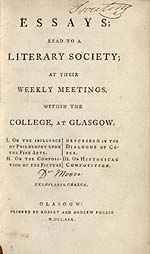 |
1759 James Moor Essays read to a literary society
Title-page.
James Moor was Professor of Greek at Glasgow University, and also the Foulis’s
brother-in-law. All three were members of the Literary Society which was based
there, and was composed mainly of its professors. Moor was a valuable proof
corrector and editor of a number of Foulis publications such as Archimedes, Arenarius,
1751. The Foulis Press also printed 17 editions of Moor’s own books including De
Analogia Contractionum Linguae Graecae Regulae Generales, 1753, and On
the End of Tragedy, 1763.
Sp Coll Mu21-d.28; Gaskell 372
|
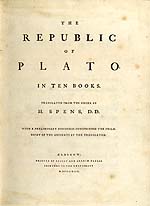 |
1763 Plato Republic
Title-page.
This edition was the first to be published in English, and was translated by
Harry Spens, DD. (1713-87). At the time he was minister of the parish of Wemyss
in Fife.
|
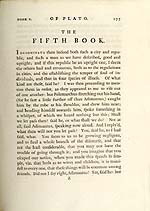 |
Text page.
In 1750 Robert Foulis planned to print all of Plato’s works in Greek and
Latin, but did not succeed. It is believed that his commitments to the art
school which he opened in 1753 overtook what could have been one of his most
ambitious printing and publishing projects.
Sp Coll Cy.1.1: Gaskell 423
|
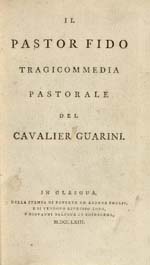 |
1763 Giambattista Guarini Il Pastor Fido
Title-page.
The Foulis Press printed and published a number of works by Italian authors
some of which were illustrated.
|
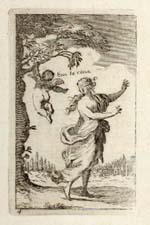 |
Illustration by Sebastien le Clerc
When Robert Foulis was travelling on the Continent buying works of art for
his new school of art, he acquired a large collection of copperplates produced
by a wide range of artists. Impressions were taken from a large number and
offered for sale in the 1758 subscribers’ catalogue. He also used plates by le
Clerc (1637-1714) to illustrate several other Foulis Press publications
including Torquato Tasso’s Aminta, 1753, and La Gierusalemme Liberata,
1763, as well as Bonarelli della Rovere’s Filli di Sciro, 1772.
Sp Coll Mu49-g.21; Gaskell 418 |
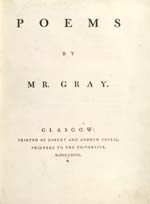 |
1768 Thomas Gray Poems
Title-page.
This publication was first proposed by Dr Beattie, the Professor of
Philosophy at Aberdeen University. He described it as ‘one of the most elegant
pieces of printing that the Glasgow press or any other press has ever produced’.
|
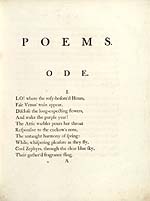 |
Text page.
A contemporary advertisement for this book indicated that this was ‘the
first work in the Roman character which they [Robert and Andrew Foulis] have
published with so large a type; and they are obliged to Dr Wilson for preparing
so expeditiously, and with so much attention, characters of so beautiful a form’.
Sp Coll BD16-a .18; Gaskell 475
|
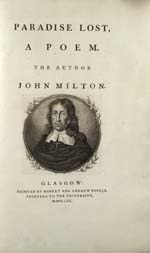 |
1770 John Milton Paradise Lost
Title-page.
This book has been described as the Foulis’s ‘last typographical
achievement in the grand manner’, and, although they continued printing for
several more years, no subsequent publications were of such high quality.
|
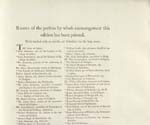 |
List of subscribers.
The Foulis brothers sought subscribers for a number of their publications.
|
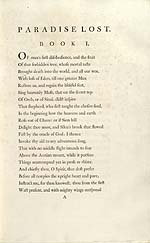 |
Text page.
The Englishman Captain Edward Topham remarked that the Foulis’s editions of
Homer’s Iliad and Odyssey, 1756-58, along with this work, ‘might
have made them immortal’.
Sp Coll Bh19-x.18; Gaskell 510
|
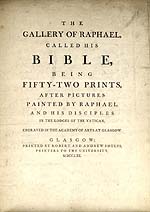 |
1770 The Gallery of Raphael, also known as Raphael’s
Bible
Title-page.
This volume of prints contains engravings made by pupils at the Foulis
Academy. It is based on the 16th-century frescoes decorating the Loggias in the
Vatican in Rome which were planned by Raphael, and undertaken by several other
artists. The title-page claims there are 52 prints but this volume and one in
the Mitchell Library in Glasgow have 54.
|
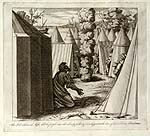 |
‘The Lord talked with Moses, Exodus XXXIX’, engraving.
There were numerous sets of engravings made after the frescoes, and the
Hunterian Art Gallery at Glasgow University owns one by Orazio Borgiani
(1577-1620) dating from 1615; and one by Pietro Aquila (c. 1643-96) from
1674.
|
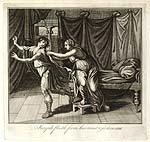 |
‘Joseph flieth from his mistress, Genesis XXXIX ‘, engraving
Only one of the engravings made for this work volume bears an artist’s
name: ‘Jacob sees Rachel at the well of Haran’, by James Mitchell (fl.
1750-74). The entire work has been attributed to him and William Buchanan
(1736-72), his fellow-pupil.
Sp Coll Mu2-x.18; Gaskell 507
|
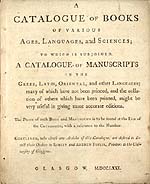 |
1771 A Catalogue of Books of Various
Ages
Title-page.
The brothers printed and published a number of catalogues, copies of which can
be found in Glasgow University Library, and also in the city’s Mitchell
Library. This particular example contains 76 pages of books, and 18 pages of
manuscripts. The price lists for both are printed at the end.
Sp Coll Mu34-e.9; Gaskell 526 |
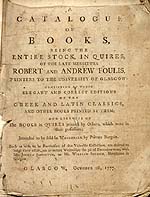 |
1777 Catalogue of books ...
Title-page.
This catalogue covers the stock which was left after Robert’s death in
1776.
Sp Coll Mu34-e.10; Gaskell 614
|